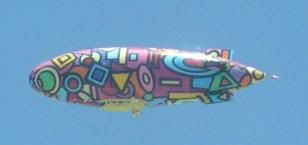Airship
An airship, or dirigible, is a lighter-than-air craft that can be either rigid, semi-rigid, or nonrigid. Unlike balloons, airships can be steered and are capable of moving against air currents. Physically and in principal, airships are more common to submarines than airplanes. Though early airships can be easily recognized by their cigar-like shape, floating weapons platforms and other lighter-than-air craft can also be considered airships.
Typically hydrogen or helium gas is used to make the craft lighter than the air, while a series of fans are used to maneuver the ship through the air. Different types of ballast, including sand, water, and metal shot, are used to control altitude and buoyancy of the craft. Cargo and passengers frequently are housed in a separate gondola or cabin, which is separated from the gas filled portion of the ship that is used to maintain buoyancy.
Since airships do not require on speed to generate lift, it is possible for the craft to travel in the wind currents. The engines, fans, do not require as much power as airplane engines, thus making airships relatively quiet and cost effective for slower air travel. Airships do not vibrate as much as airplanes and helicopters, making them a more stable air platform for scientific measurements.
Airships which require a rigid frame are sometimes called zeppelins, while nonrigid airships that require pressure to retain their shape are commonly referred to as blimps.
Contents
NationStates Use

Airships are used by a number of nations for military, transportation, recreational, and advertising purposes. Though in most nations, airships are used less extensively than airplanes and helicopters, some nations rely on airships more than other forms of airtravel. In some cases this is due to a cultural identification with airships, but in some nations, airship travel may also be more economically feasible than in nations where airships are less likely to be found.
List of Airlines that use airships:
- Confederate Airways (Malartia)
- Eule Fluglinien (Mikitivity)
- Leninia-Trotskya Dirigible Service (Leninia-Trotskya)
- Royal Aerionian Airborne Cruises (Aerion)
List of International airports that serve airships:
- Coranum Aerodrome
- Balkan City International Airport
- Flughafen Biberwiesen
- Luntat Airship Station
- Ωn-Baranxiž International Airport
- Edward City Son Sant Joan International Airport
List of airship manufacturers:
- Confederate Airship Works (Malartia)
- Franberrian Airships
- Ironscale Heavy Lift
- Phoenix Dynamix
- Royal Aerionian Airship Corporation (Aerion)
- Schmeiser Luftschiffaufbau (Mikitivity)
- TRident Industries (Kroblexskij)
- Zepplin Manufacturers (ZMI)
Classes / Models
List of NS Airship Classes
- AAD-1 Airborne Air Defense Platform(Phoenix Dynamix)
- Hyperion Class Rigid Airship(Phoenix Dynamix)
- Imperial Zeppelin (The Reich)
- Luftschiff 47 (Schmeiser Luftschiffaufbau)
- Metropolitan Airship
- Revolution Class Airship (Kroblexskij)
- Spartan Fleet Defense Blimp(Phoenix Dynamix)
- Trojan/II Class Rigid Airborne Aircraft Carrier(Phoenix Dynamix)
Special Considerations
Some airports are not equipped to handle airship traffic. High winds can make take off and landing difficult, and fuel (hydrogen or helium availability) and maintenance issues may limit the ability of airships from one nation to travel to the airports of another nation. Travel times associated with long-distance travel has discouraged many nations from using airships for passenger or cargo transport. However, airships are still capable of making transcontinental trips, and are still in use in many NationStates societies.
Real-Life Historical Use
In RL, the airship was mainly used militarily before and during the First World War. The Italians used semi-rigids to scout and bomb during the Italo-Turkish War, and World War I.
During WWI, the Germans used rigid airships from the Zeppelin and Schutte-Lanz companies as bombers and the English and French used a variety of airships for scouting, but never in the strategic role as the Germans did.
During the 1930s, the US used two rigid airships (The USS Akron and USS Macon) as fleet scouts, but both crashed (in 1933 and 1935 respectively).
In RL, the airship began to decline as soon as aircraft could match its altitude and shoot it down, but in Nationstates it could be used by Past Tech nations as bombers or fleet scouts as in RL, or alternately as "Flying Aircraft Carriers" or "Flying Battleships."
Airships are also common in real-life science fiction and pre-WWII fictional stories, where authors make use of the ships to reinforce alternative realities.
Additional Info
- Reservations for Airship Cruise Example of a NationStates roleplay focusing on airship travel
- Blimpinfo.com Lighter-Than-Air Society Homepage
- American Blimp Company
- Airship Wikipedia Article

